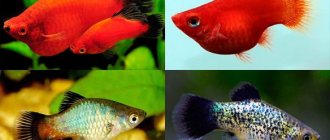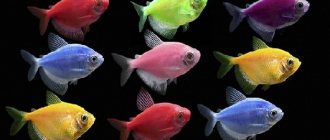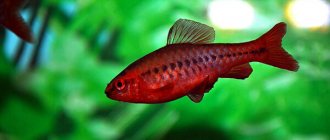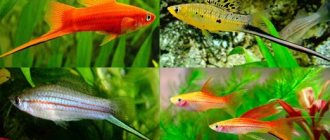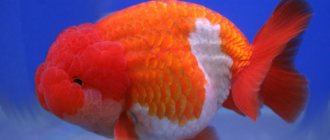Ameka is an active and unpretentious fish. In its natural environment, it lived in Mexico in closed mountain rivers. The name of these fish comes from one of them (Rio Ameca).
But at present, this fish is practically not found in natural conditions, so all modern representatives were bred in an artificial environment. This article will tell you about the proper maintenance of fish, their reproduction, give recommendations for feeding, and describe the differences between males and females.
Maintenance and care
Ameka glossy is easy to care for and maintain. It quickly adapts to temperature changes and changes in the chemical composition of water. But, nevertheless, to maintain good health of the fish, the following rules must be followed:
- one of the main requirements for these fish is clean water;
- For an aquarium you need to purchase a filter. It does not tolerate nitrates and nitrites in water well;
- for every 10 individuals in the aquarium there should be at least 60 liters of water;
- To keep this fish, it is advisable to purchase aerators, since it requires a sufficient amount of oxygen in the water. The air bubbles should be small;
- The tank needs to be cleaned regularly as it leaves large amounts of excrement. You also need to periodically remove plaque from the aquarium glass;
- The aquarium must have a lid. This fish is active, so it often jumps out of its home pond;
- There must be enough free space in the tank. Fish should not touch plants and decorations while moving;
- to imitate natural conditions, you can create an artificial current for the fish in the aquarium;
- a third of the water in the aquarium needs to be replaced once every 7 days. The second option is to change a tenth of the liquid every day;
- At night, turn off the lights or make them more dim. At this time of day, Ameka falls asleep;
- at night it is also recommended to reduce the water temperature by several degrees;
- The ideal temperature range is from 18 to 24 degrees. But they tolerate both an increase in temperature up to 30 degrees and a decrease in temperature down to 15 degrees;
- water hardness should be from 6 to 11 units;
- acidity from 6.5 to 7.5;
- in the aquarium it is necessary to make enough plants, thickets, and decorations to imitate natural conditions. In its natural environment, this species lives in rivers with a lot of algae and other vegetation. In addition, this will give Ameka the opportunity to have privacy for mating and reduce the stress level of the fish;
- females must predominate in a flock. There should be about 20 of them. There should always be more than 4 males. The optimal number of males is 8-10. This will help prevent low-ranking males from dying from extreme stress due to increased competition. Fights often occur between males, as a result of which the leader of the pack is revealed;
- It is better to use dark-colored material as a substrate. Such a background will highlight the beauty of Ameca.
It is worth considering that the peak of activity occurs during the daytime. It is able to swim in all layers of water - both in depth and in shallow water.
Habitat
The fish originates from Central America; wild populations are common in some mountain rivers, in particular the Rio Ameca and its tributaries, flowing along the city of the same name near Guadalajara, the capital of the state of Jalisco in Mexico. In 1996, this species was included in the list of extinctions from its natural habitat, but modern research has established that the fish still inhabit this area. Requirements and conditions:
- Aquarium volume - from 80 liters.
- Temperature – 24 – 32°C
- pH value – 7.0–8.0
- Water hardness: medium hard (9–19 dGH)
- Substrate type - any dark
- Lighting - moderate
- Brackish water - no
- Water movement - moderate
Fish parameters:
- Size - up to 9 cm.
- Food - any
How to distinguish a female from a male
These fish have pronounced sexual dimorphism. Males are smaller in size and have more pronounced body coloration. They have black and yellow trim on the tail. The belly of males also has a yellow tint. And the back of their body is colored green. The main male in the flock has a bright yellow crescent on his tail. The higher the rank of the male, the more intense the body coloring will be.
Females are larger in size than males. Due to viviparity, their abdomen has a rectangular appearance. The body of females is silver with black dots. And their tail fins are transparent.
Gambusia
This not the brightest fish became famous after its mass spread to the tropical regions of the planet to fight the larvae of the malarial mosquito, which mosquito fish happily eats in large quantities. This made it possible to sharply reduce the number of people who suffered from a dangerous disease - malaria. Several monuments were even erected to the fish for his services. Its natural habitat is the Missouri River basin.
The size of mosquito fish in an aquarium does not exceed 4 cm (males) and 7 cm (females). In appearance they are very similar to guppies, but their colors are much more modest: a grayish-green body and transparent fins.
The fish has increased endurance and takes root well in aquariums. It is better to keep them in flocks of 5-6 individuals. It is not very peaceful and is prone to biting off the fins of its neighbors. Gets along well with cardinals, danios and barbs.
What to feed Ameka and how to breed it in a community aquarium
When feeding, it is important to maintain variety and balance in the diet. Amecas have a good appetite. They are omnivores.
Suitable dry, live and plant food. The first type of food is plant flakes, specialized food, and frozen organic food. From the second - earthworms, shrimps, cyclops, tubifex worms, bloodworms. For the third - zucchini, lettuce, spinach, pureed green peas. Mainly prefers plant foods.
But it is worth remembering that an excessive amount of flakes in the diet of this fish can cause obesity and then infertility. Feed in small portions 2-3 times a day.
They also feed on duckweed and aquarium filamentous and blue-green algae. But they usually don’t eat blackbeard. Amecs often have competitions for food. Often females drive each other away from the desired delicacy. Representatives of this species can feed on the fry of another species, but they do not eat their own offspring.
Ameka reaches sexual maturity at 6 months. Pregnancy lasts from 7 to 10 weeks. A separate aquarium is not required for breeding. But to give birth, the female needs an individual tank with water from the previous aquarium. If a pregnant female’s abdomen is very swollen, then it’s time to move her to a separate container.
The birth process most often occurs in shallow water. You should not change the water in the birth aquarium every day, as this will provoke the appearance of premature fry. The first fluid change should be done at least 2-3 days later. Also, before giving birth, the female needs to be provided with increased feeding and diffused light. Otherwise, there is a risk of miscarriage. There should also be enough floating plants nearby.
The birth process can last up to 2 days. But you need to be prepared for the fact that in most cases the female’s first brood does not survive.
Ameka gives birth to from 5 to 20 cubs. The fry are born fully formed. After just a few days they can feed on their own. Their length is approximately 2 cm. And at first you can see placental threads. Babies can be fed dry and small live food.
Breeding/reproduction
They are easily bred at home and do not require special conditions or a separate tank. Spawning can take place at any time during the year. The female initiates the mating season by swimming diagonally next to the male and performing tremulous movements. When the male is ready, mating occurs. Pregnancy lasts from 55 to 60 days, during which time the abdomen swells greatly. The fry appear fully formed and are ready to take regular food, only in crushed form. It can be kept with its parents; no cases of cannibalism have been observed. The peculiarity of this species from other viviparous fish is that during pregnancy the female develops special internal structures, similar to the placenta in mammals, through which the fry are fed. Due to this, the fry stay much longer in the womb and, upon emergence, are already completely self-sufficient. In the first days, the fry have noticeable small appendages, the remnants of that very “placenta-umbilical cord”.
Compatibility with other fish in the aquarium
Ameka glossy is a lively and active fish. A flock of them can hunt for one individual and try to bite off part of its fin. Therefore, this species should not be housed with slow fish or those with veiled tails. It is equally important to take into account the parameters of maintaining new neighbors.
The best neighbors will be Barbs and Loaches; they are similar in temperament to Ameka. Neighbors must match in size. If you add small fish to them, the Ameks will bite them and eat their food. If the neighbors are larger, they will begin to oppress the first inhabitants of the aquarium.
Well compatible with:
- Barbs;
- Tetras;
- Loaches;
- Swordtails;
- Pecilia;
- Rainbows;
- Corridors;
- Cherry shrimp;
- Neretina snail.
However, she cannot be housed with the following inhabitants:
- Veil;
- Guppy;
- Danio;
- Ternetia;
- Mollies.
Girardinus metallicus
Ghirardinus metallicus, as the name suggests, is metallic in color. The color ranges from silver to gold, depending on the lighting, and there are also vertical stripes on the body, but they are almost invisible.
Males have black spots on the head, throat, and anal fin. Sometimes they merge, but are expressed differently in each fish. As often happens in viviparous species, Ghirardinus females are larger than males and grow up to 7 cm, while males are 3-4 cm.
Ghirardinus metallicus
Girardinus metallicus is a charming fish that will live wonderfully in an overgrown aquarium with a volume of 40 liters or more.
Unpretentious, they naturally live in brackish water, but in an aquarium they tolerate completely fresh, moderately hard water.
Given their size, neighbors for them need to be selected carefully. Cherry shrimp and neretina snails, corydoras and small barbs, tetras, rainbows and other peaceful fish and invertebrates are perfect
If you bred one of the standard viviparous breeds, then the principles are the same here. To begin with, there must be more females than males, otherwise they will chase the females in a way that leads to stress.
Then you need floating plants, such as pistia. They will provide shelter for both females and fry. Although Girardinus metallicus does not hunt its young, fish can still eat it.
And when there are floating plants on the surface, it is very easy to catch the fry hiding in their shadow in the morning.
Ameka's diseases
Ameka glossy has strong immunity. Under favorable conditions, they are rarely susceptible to disease.
But if the aquarium is not properly maintained or unhealthy fish are placed in it, then the Ameks will begin to get sick. Their immunity will be greatly reduced and they will become infected with a bacterial infection or pathogenic microorganisms.
Main diseases:
- obesity
Appears due to excess nutrition with food high in carbohydrates. Sick fish have a very prominent belly. They begin to look well-fed. In the future, this condition becomes the cause of infertility. Therefore, to prevent obesity, fish need to have fasting days;
- anoxia
Sometimes the fish experience oxygen starvation. In this case, they constantly swim to the surface of the water and swallow air. This leads to decreased appetite, decreased growth, and a weakened immune system;
- gas embolism
The main symptom is large air bubbles on decorations and aquarium plants. Over time, they switch to fish, which become shy and restless.
Endler's guppy
These lively, colorful fish from the Cyprinodontiformes family are very easy to keep and breed. But their fertility and unpretentiousness made Endler’s guppies (2-4 cm fish) ideal live food for aquarium predators. It is not recommended to put small guppies in a tank with large, voracious individuals, if there is no goal to feed the latter.
The homeland of this breed of fish is the northern part of Venezuela; they once lived in the brackish lakes of the lagoons in Carapano. But today Endler's guppies are not found in the wild. The fish are brightly colored, combining green, red, orange and silver shades. As a rule, males are smaller than females and are more intensely colored.
For a flock of guppies, you will need an aquarium with a volume of at least 40 liters, the water temperature should be no colder than 24°C and no higher than 30°C. There are no special requirements for lighting or soil; they are omnivorous and peaceful. Guppies live in numerous schools; 10-15 individuals can be placed in a 40-50 liter tank. It is recommended to change the water weekly, and remove waste as it appears. No special design of the container is required; it is enough to plant a few plants.
Ameka, video:
Conclusion
To keep Ameka comfortable, you need to maintain a temperature range of 18-24 degrees, have an aquarium with a lid, create dim lighting at night, and provide enough secluded places in the tank. You need to feed 2-3 times a day with live, dry, plant food. The diet should be balanced and varied. A separate aquarium is not required for breeding. It will only be needed for childbirth. A pregnant female needs increased feeding and diffused lighting. Capable of reproduction after 6 months. The male differs from the female in its smaller size and brightly colored body and fins.
Share with friends on social media. networks
10% DISCOUNT FOR BUYERS FROM REGIONS OF RUSSIA AND CIS COUNTRIES FOR AQUARIUMS, FISH, PLANTS, ETC.
General information
Almost every aquarist has at least once thought about getting offspring from their beloved pets. After all, the spawning process itself, which is accompanied by fascinating “mating dances” in many fish, and the resulting result are also interesting, since thanks to crossing, very interesting color forms can be obtained in the offspring.
Breeding spawning fish is a more complex process, which usually requires a separate spawning aquarium, the creation of special conditions that stimulate spawning, etc. With most viviparous fish everything is much simpler. They can easily spawn in a general aquarium, and the creation of special conditions, as a rule, is not required. It is easier to feed fully formed fry, because from birth many of them can eat ready-made dry food for fry.
We present to your attention the 10 most popular viviparous fish that you can keep in your aquarium.
Neon iris (Melanotaenia praecox)
The neon iris (lat. Melanotaenia praecox) or melanotenia praecox is an active, beautiful and very interesting fish. This is a small iris that grows up to 5-6 cm, for which it is also called dwarf.
But at the same time they are very brightly colored - pinkish-gray scales, shimmering at the slightest change in the incidence of light, for which they got their name.
The neon iris is a rather whimsical fish that cannot be kept in a newly started, unbalanced aquarium.
It requires a spacious and long aquarium, since the neon is very active and needs free space for swimming.
Of course, you need fresh water with stable parameters and changes. Also, the aquarium must be covered; they can easily jump out of the water.
Philomena or red-eyed moencausia - one of the forgotten tetras
Filomena or red-eyed Moenkhausia (lat. Moenkhausia sanctaefilomenae), was once one of the most common tetras in the aquarium. A school of these characins can decorate and enliven any aquarium, but at the moment it has lost popularity to other fish. Although the phylomena is not as bright as other tetras, it has its own charm. Red eyes, a silvery body and a black spot near the tail, in general, do not make much of an impression, but together with the lively behavior they create an interesting fish. And if you consider that they are quite unpretentious and easy to breed, then you get a good aquarium fish, even for beginners. Just keep in mind that Philomena, like all tetras, loves to live in a school of 5 fish or more. For such a flock you need an aquarium of at least 70 liters, with open swimming areas.
Habitat in nature
The red-eyed tetra moencausia was first described in 1907. It lives in South America, Paraguay, Bolivia, Peru and Brazil. In nature, it lives in the clean, flowing waters of large rivers, but from time to time it can move to tributaries, where it looks for food in dense thickets. She lives in flocks and feeds on insects. https://www.youtube.com/watch?v=fIkzK8y0p4I
Description
Philomena grows up to 7 cm and life expectancy is about 3-5 years. Her body is silver, with a large black spot near her tail. It is also called the red-eyed tetra due to its characteristic eye color.
Difficulty in content
An unpretentious fish, well suited for beginner aquarists. In nature, it tolerates global changes in water parameters during the changing seasons, and can also adapt well in an aquarium.
Feeding
Filomena is an omnivorous fish; in the aquarium it eats all types of live, frozen or artificial food. They can be fed high-quality flakes, and additionally given live and plant foods. Adding plant foods improves fish health and enhances coloration. If you can’t give them, you can buy fish food with spirulina.
Keeping in an aquarium
This is a fairly unpretentious fish, but moencausia feels good only in a school of relatives. It is advisable to keep 5-6 fish or more in an aquarium of 70 liters or more. They don't like strong currents, so make sure the filter doesn't create a strong current. In nature, in the habitats of phylomena, the light is not very bright, since the river banks are covered with dense vegetation. It is better that the light in the aquarium is diffused, which can be done with the help of floating plants on the surface of the water.
It is also advisable to plant the aquarium densely with plants, but leave open areas for swimming. You can add dry leaves of trees to the aquarium, which abundantly cover the bottom of tropical rivers. As for the water parameters, they may be different, but the ideal ones will be: temperature 22-28C, ph: 5.5-8.5, 2 - 17 dGH.
Compatibility
Well suited for keeping in a community aquarium, provided that it is kept in a school. They can frighten calm fish, as they are very active, so choose equally vigorous neighbors. For example, thorns, zebrafish, neon irises, rasbor. They can pluck the fins of fish; they cannot be kept with veiled forms, or just slow-moving fish with large fins, such as angelfish. If this is not possible, then keeping the fish in a school significantly reduces this behavior; the fish develop a hierarchy and understand each other.
The only real difference between the female and the male in Filomena is that she is fuller and rounder.
Breeding
Egg-laying species that are quite easy to breed. They can spawn both in a flock and in pairs. The easiest way to breed phyllomen is in a flock consisting of 6 males and 6 females. Before spawning, they need to be fed generously with live food, and they can lay eggs both in a general and in a separate aquarium. Of course, it is better to plant them. Spawning begins in the morning, at dawn. The female lays eggs on tufts of moss or nylon threads. The caviar falls into them and the parents cannot eat it. The water in the spawning tank should be soft and with a pH of 5.5 - 6.5, and the temperature should be increased to 26-28C.
After spawning, the spawners are removed. The larva hatches within 24-36 hours, and the fry will swim in another 3-4 days. The starting food is ciliates and yolk; as they grow, they are transferred to microworms and artemia naupilia.
catfishes.ru>
